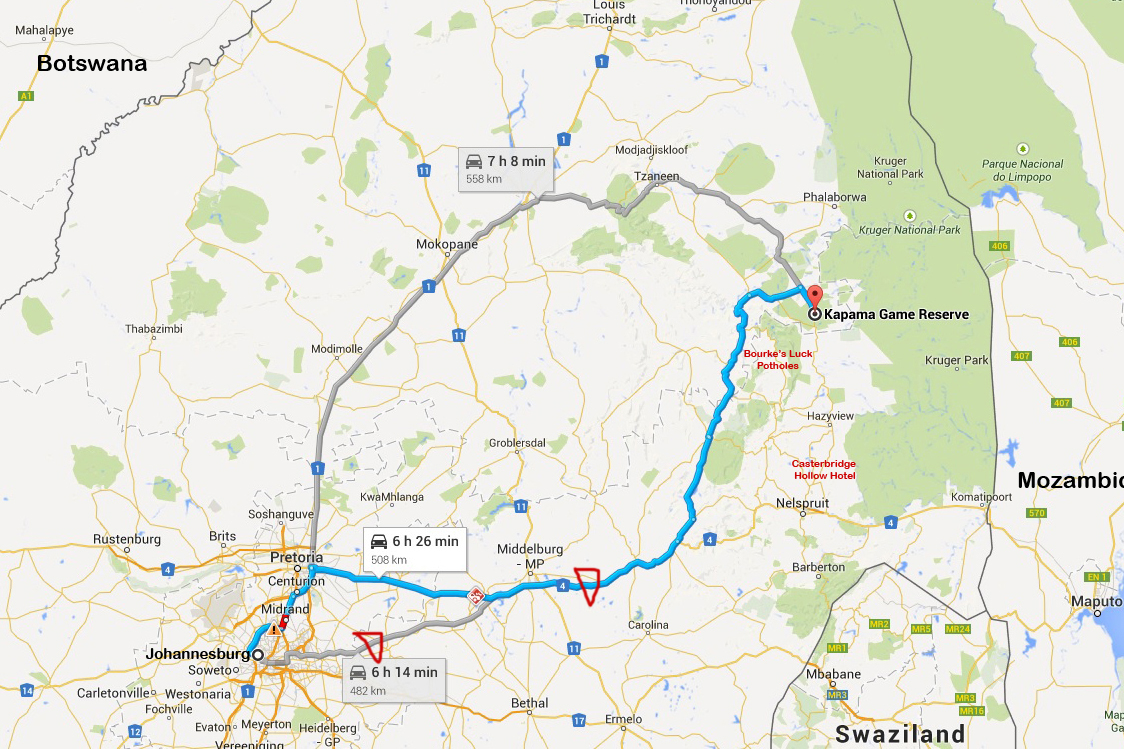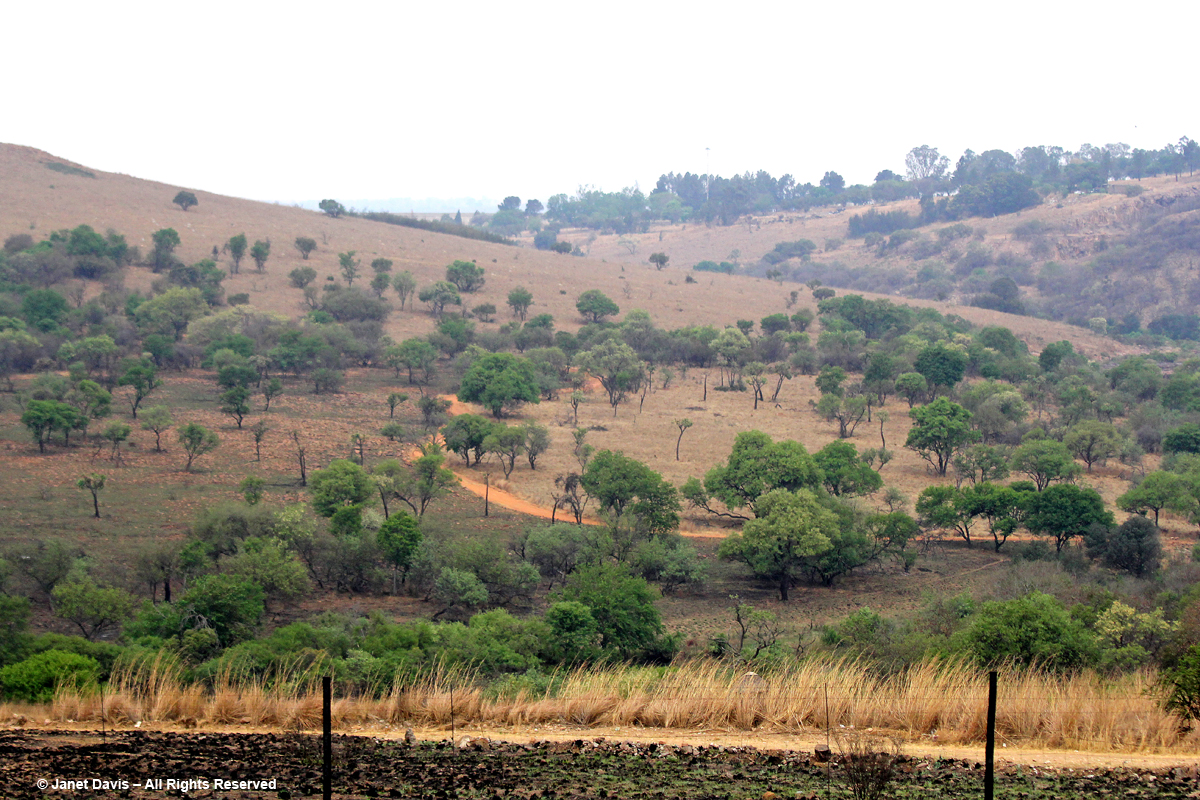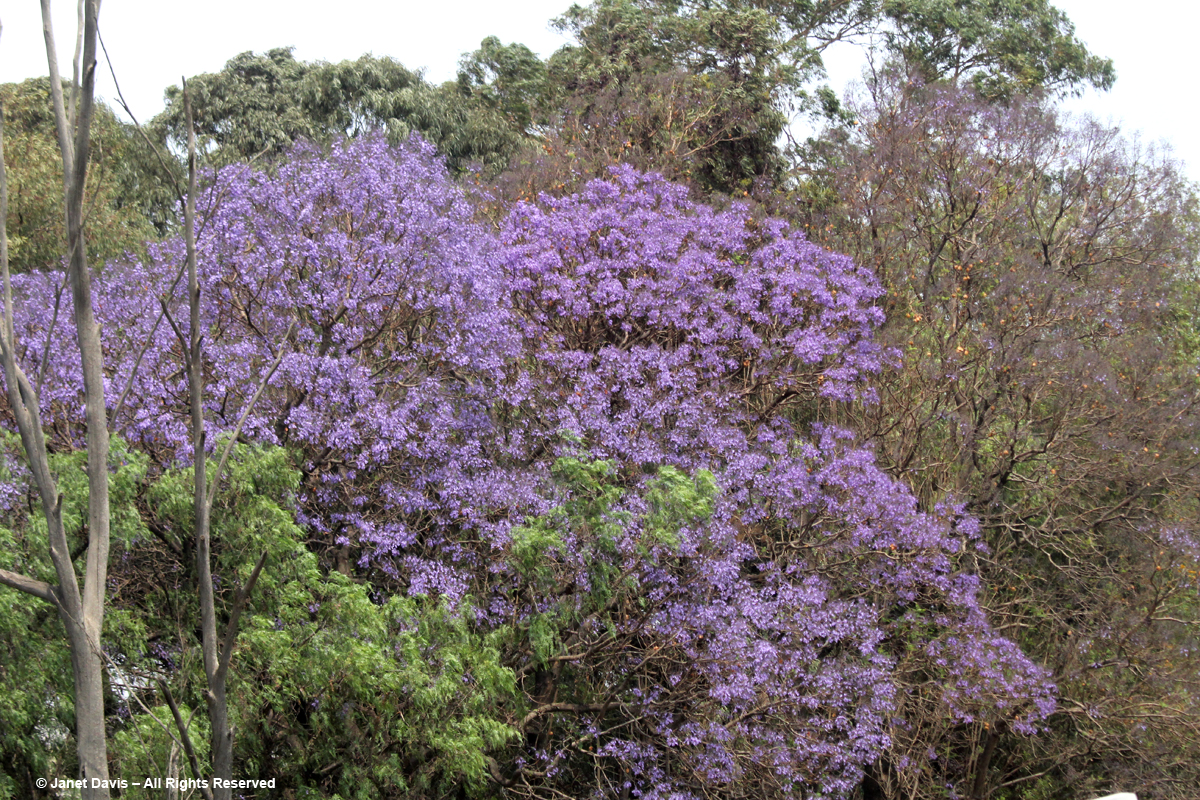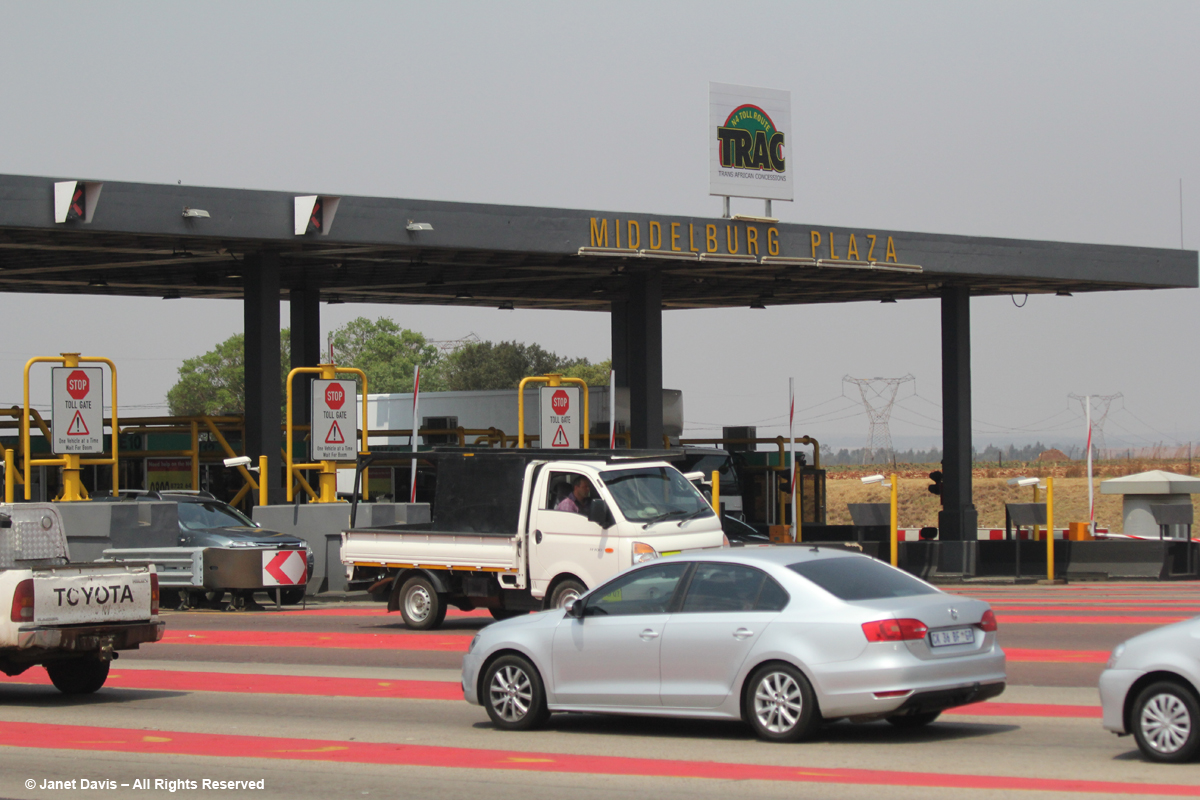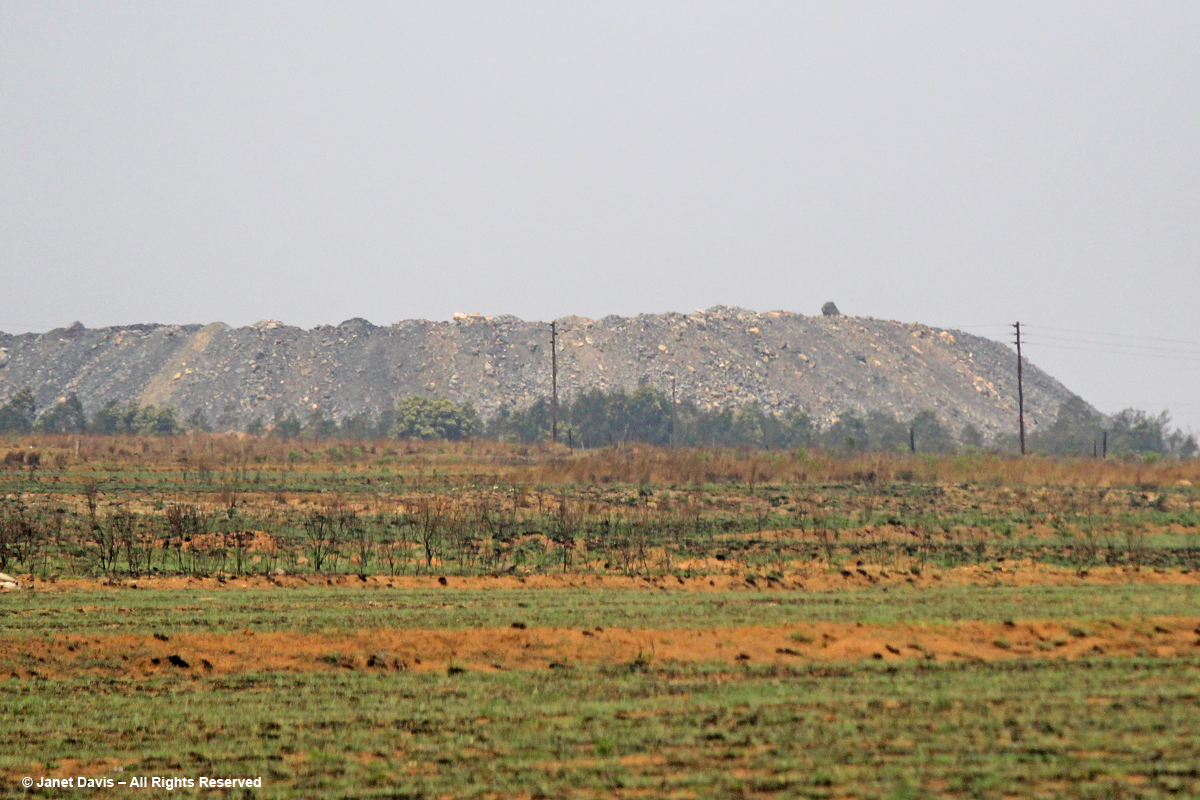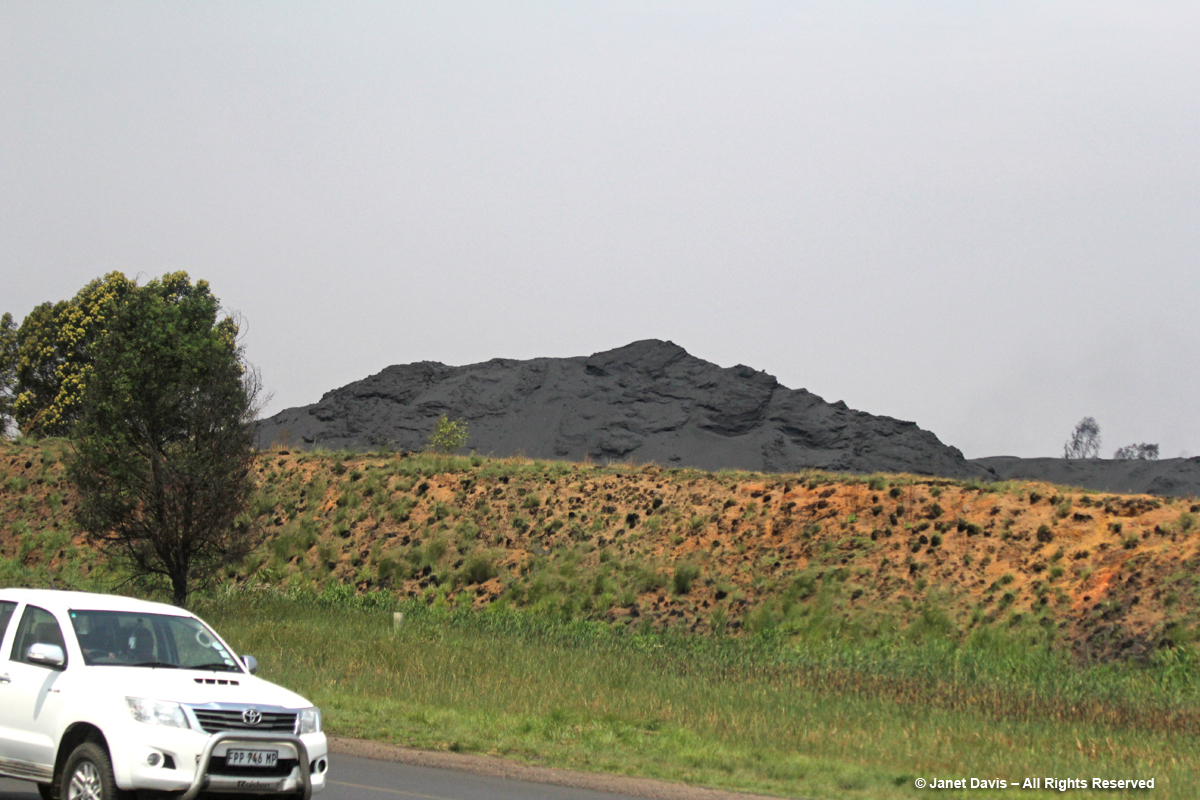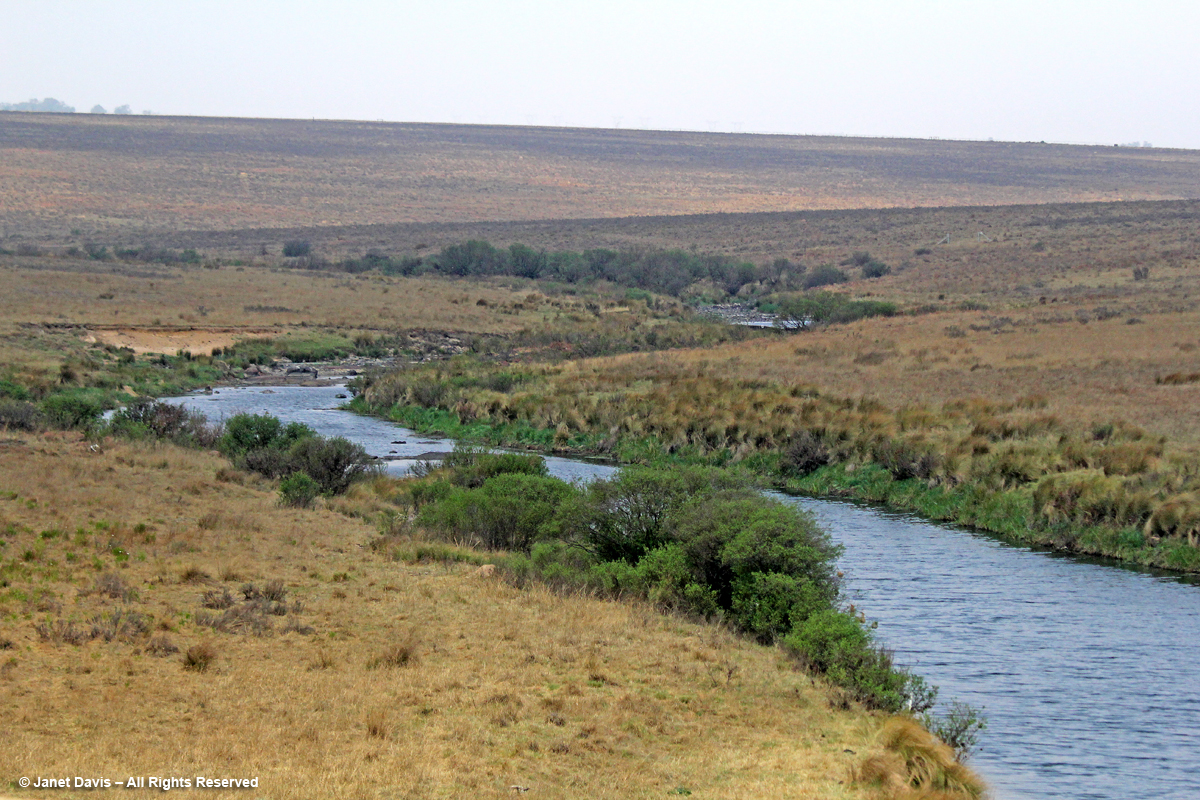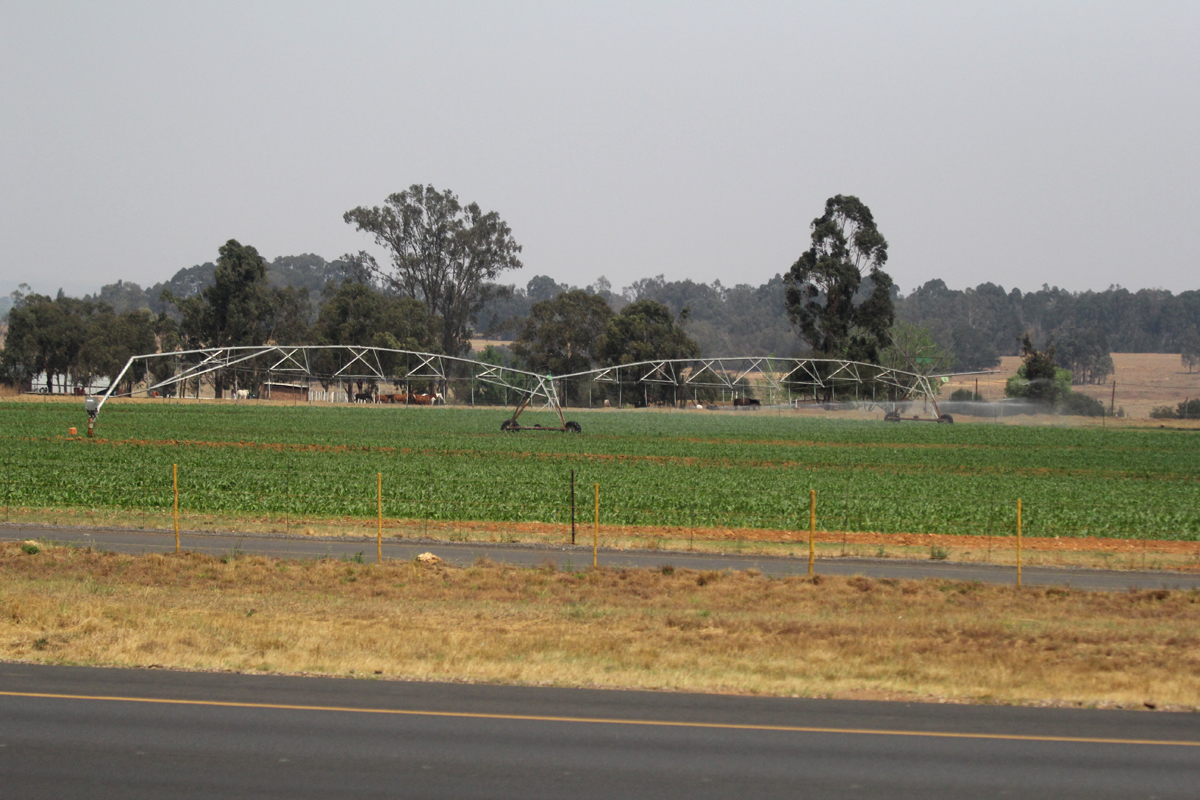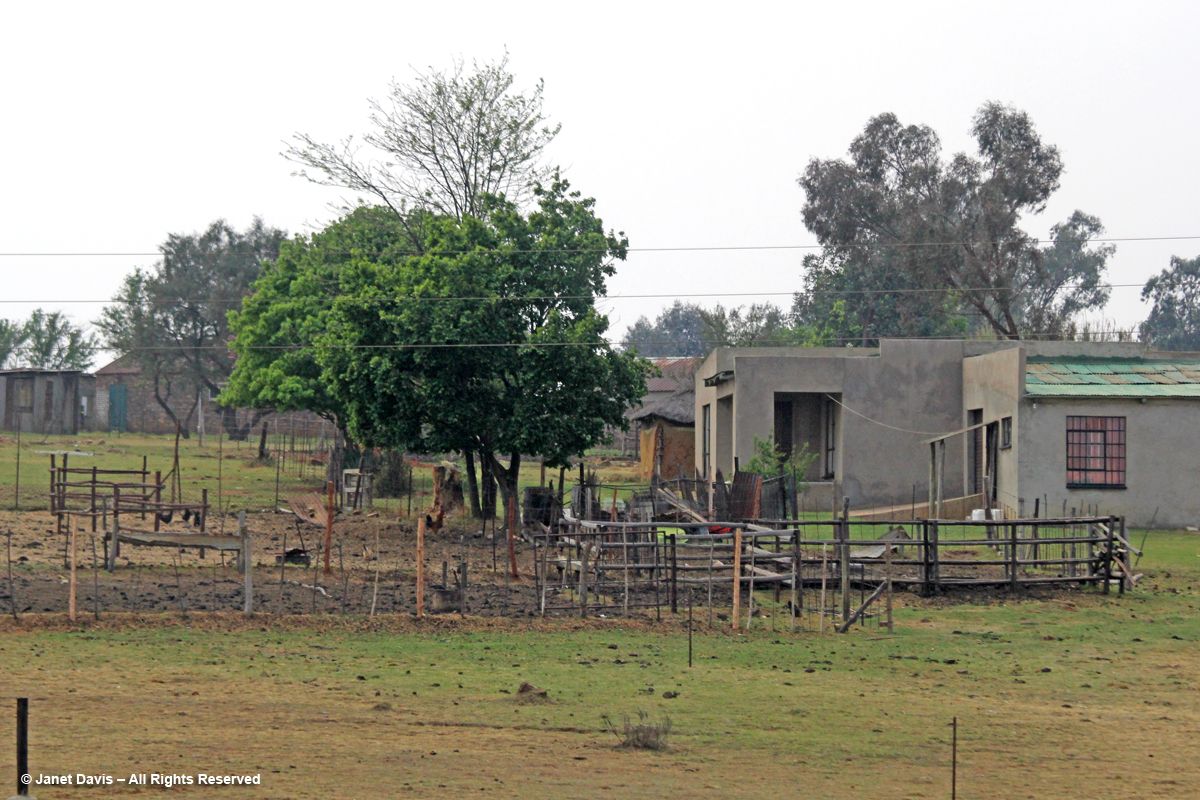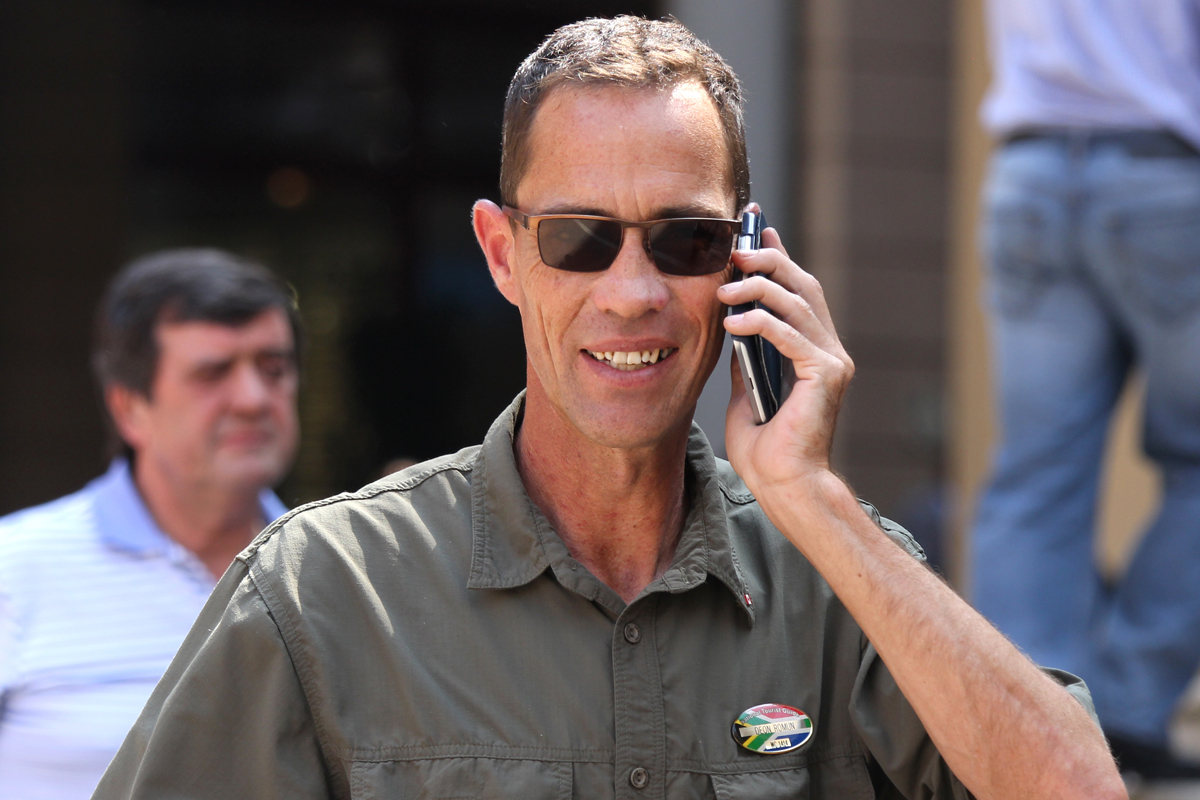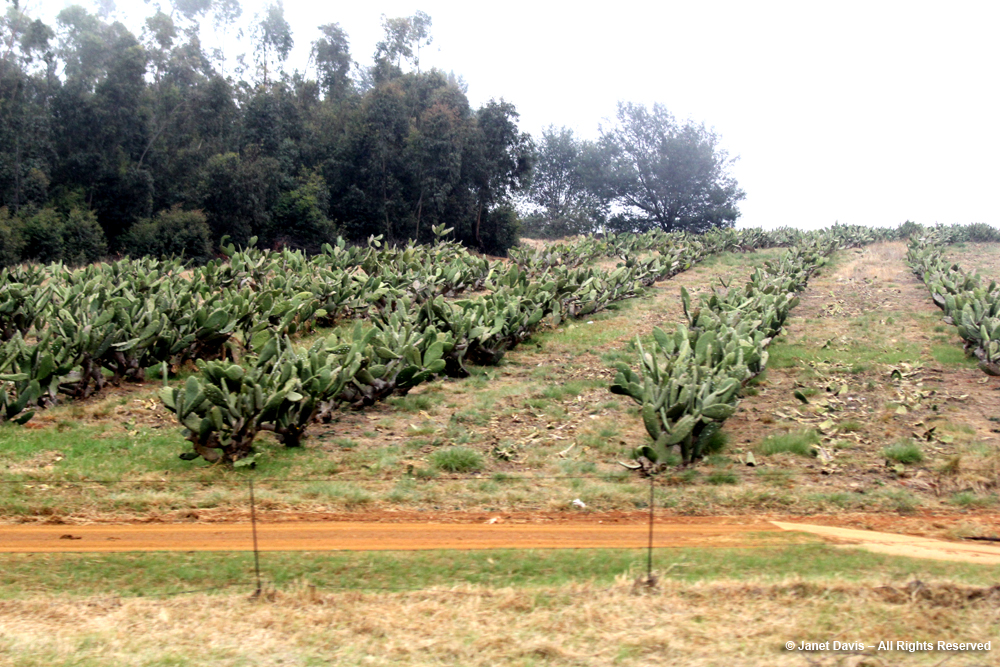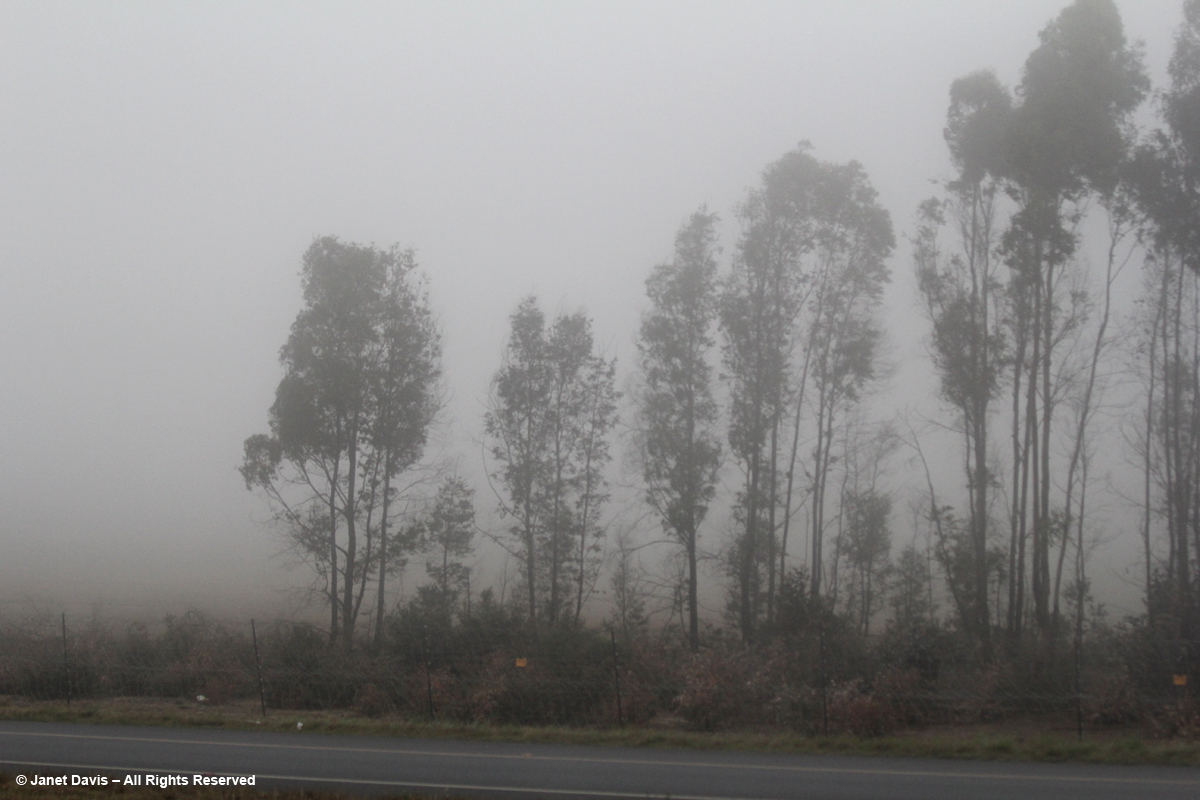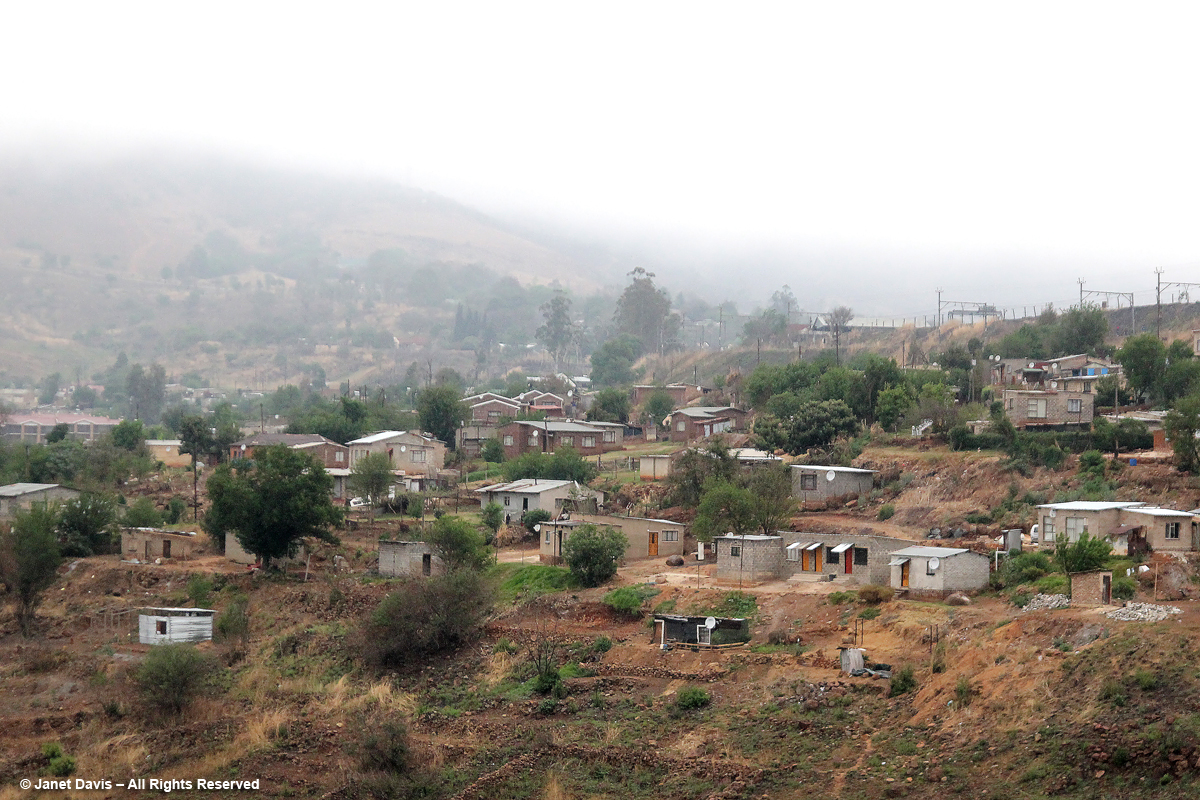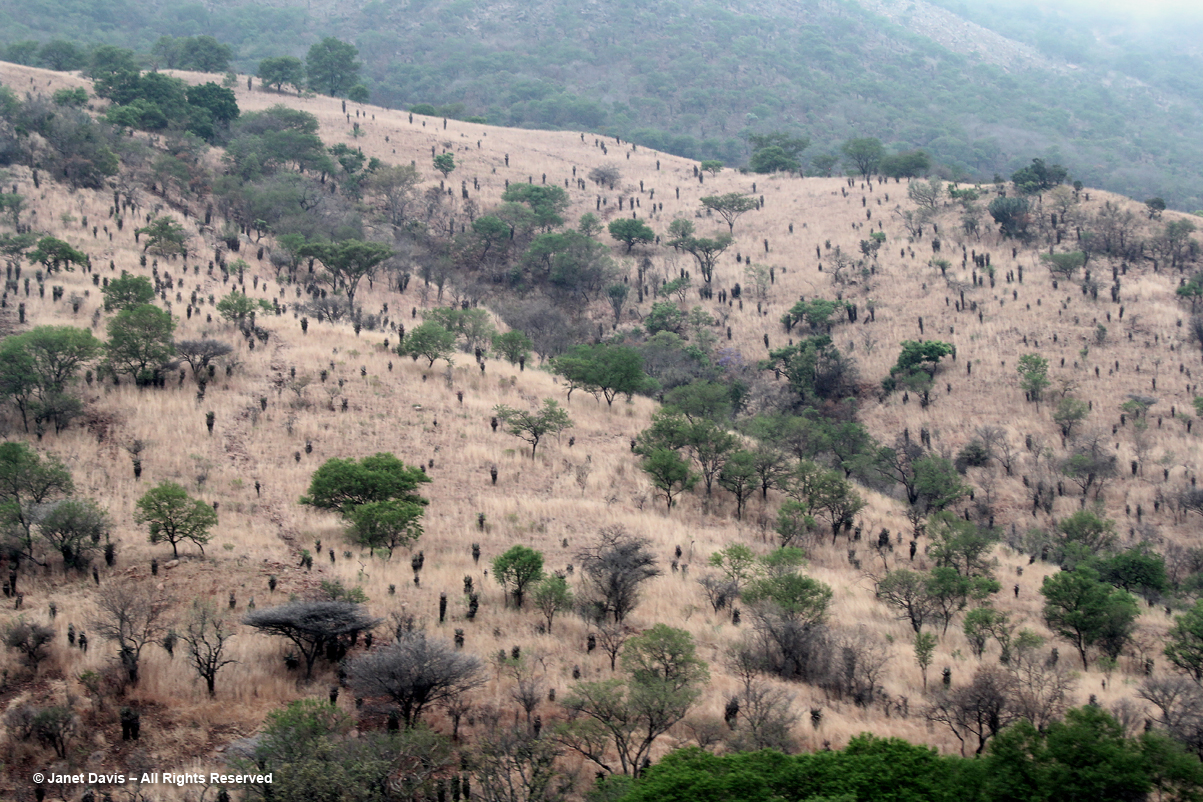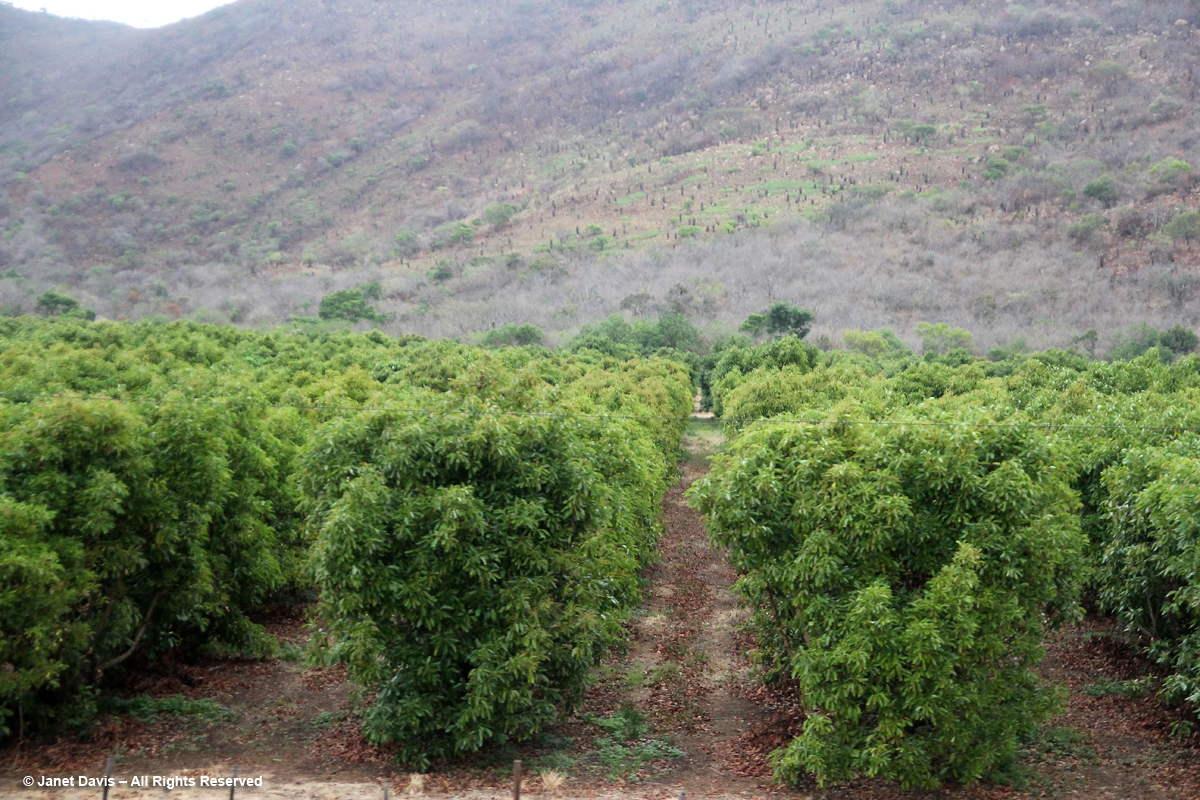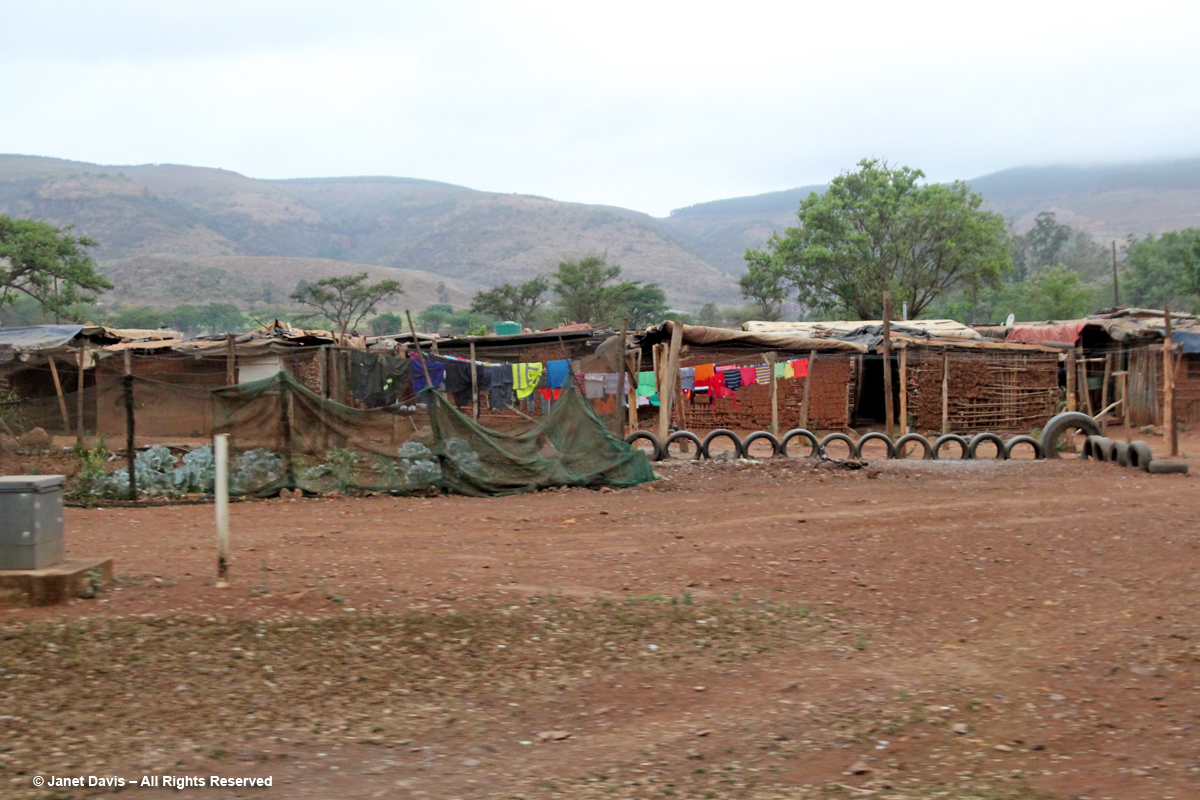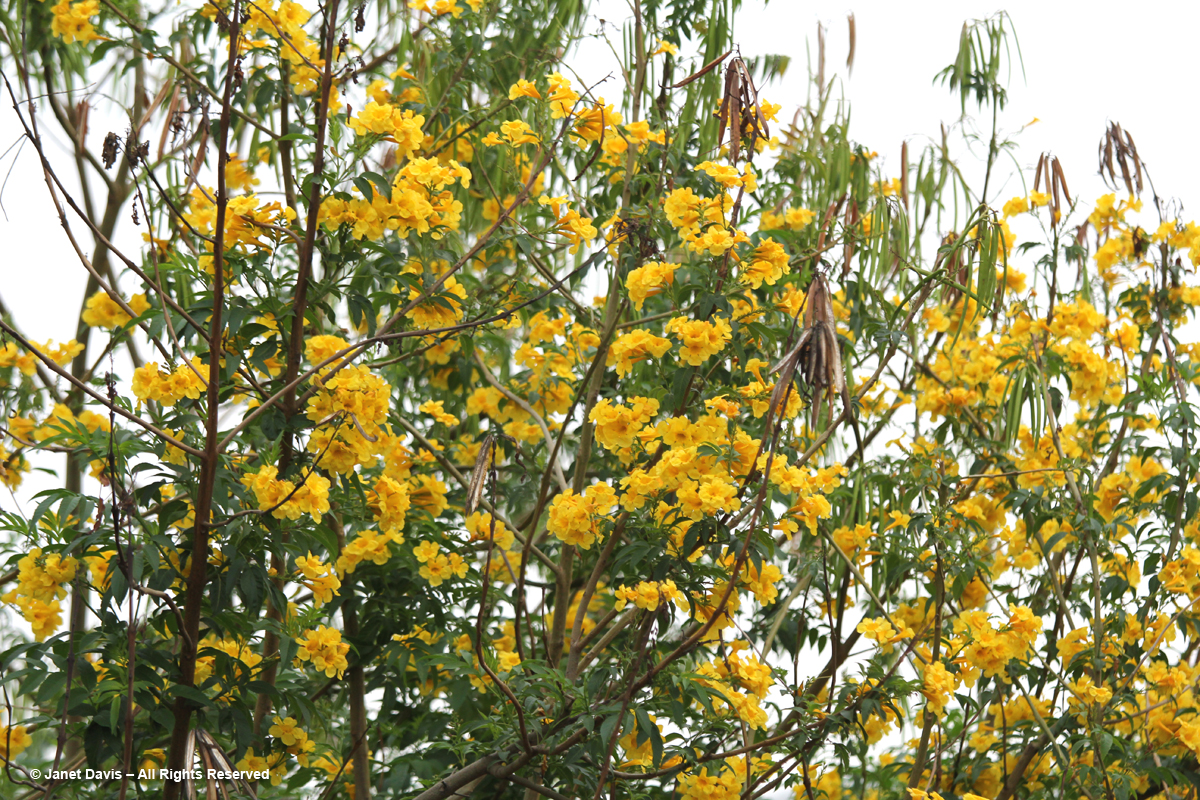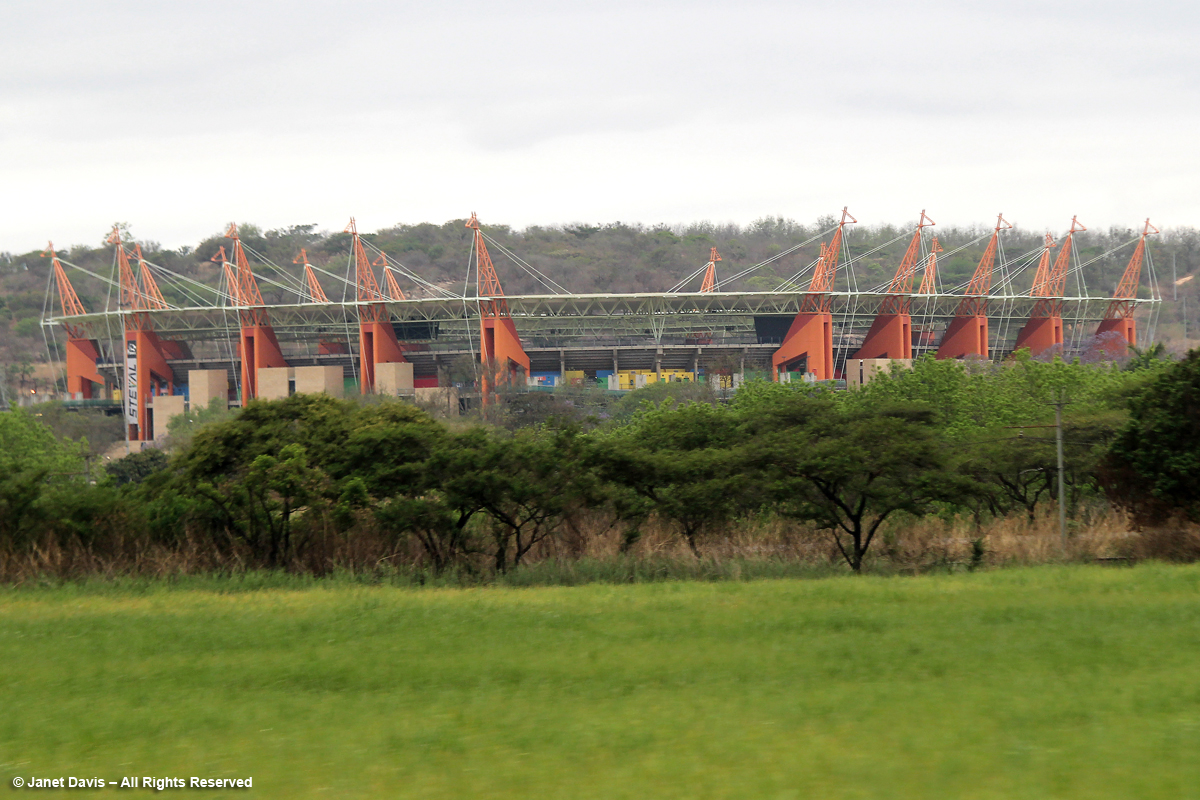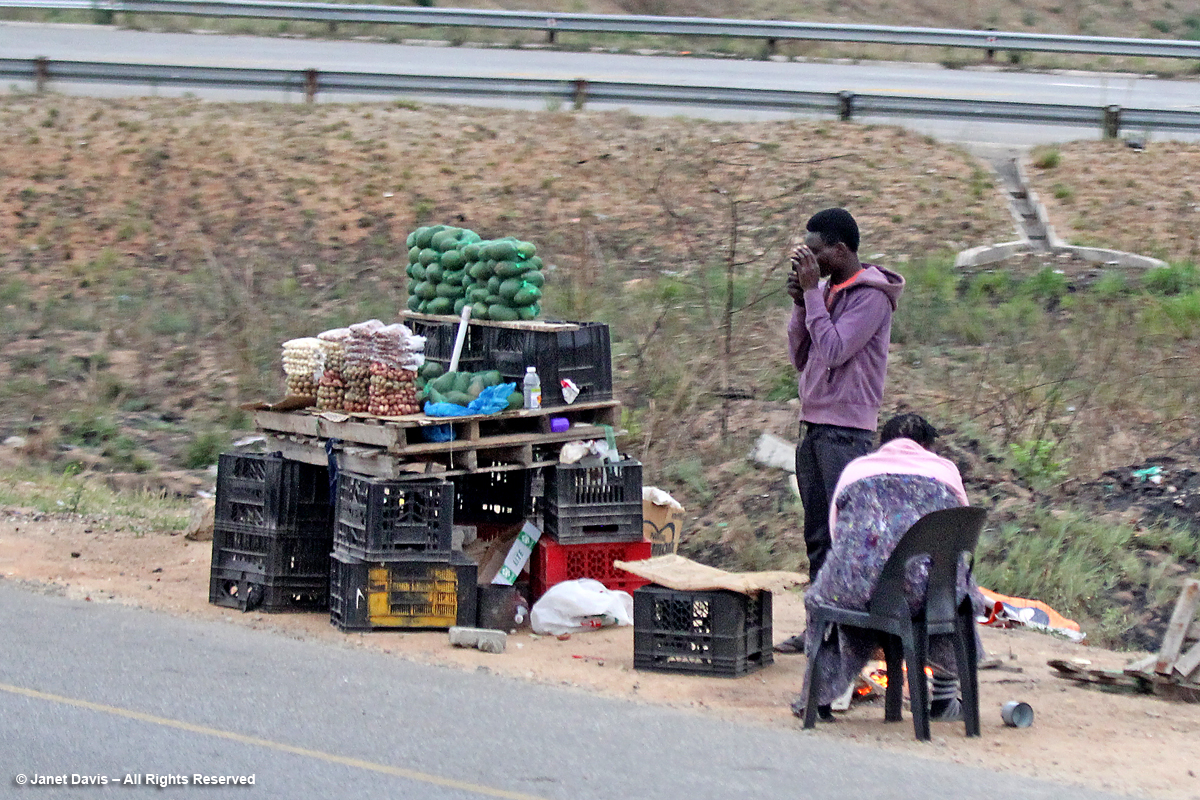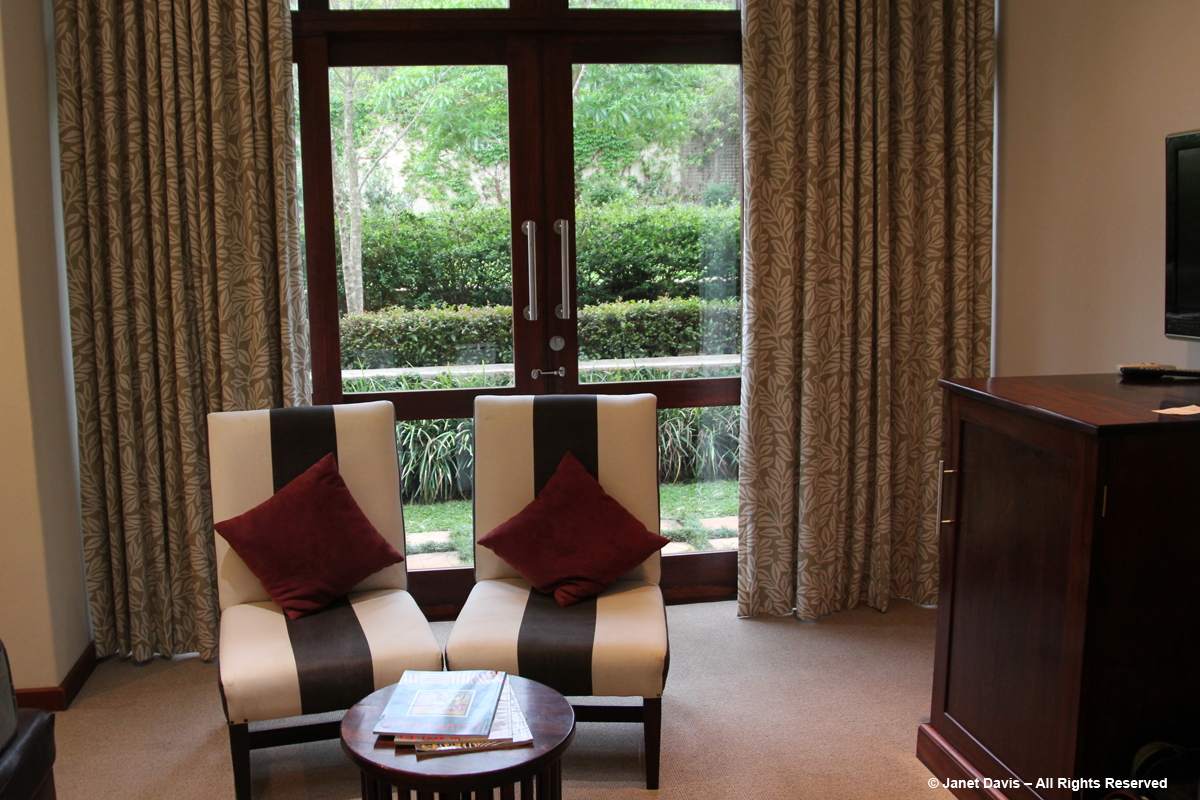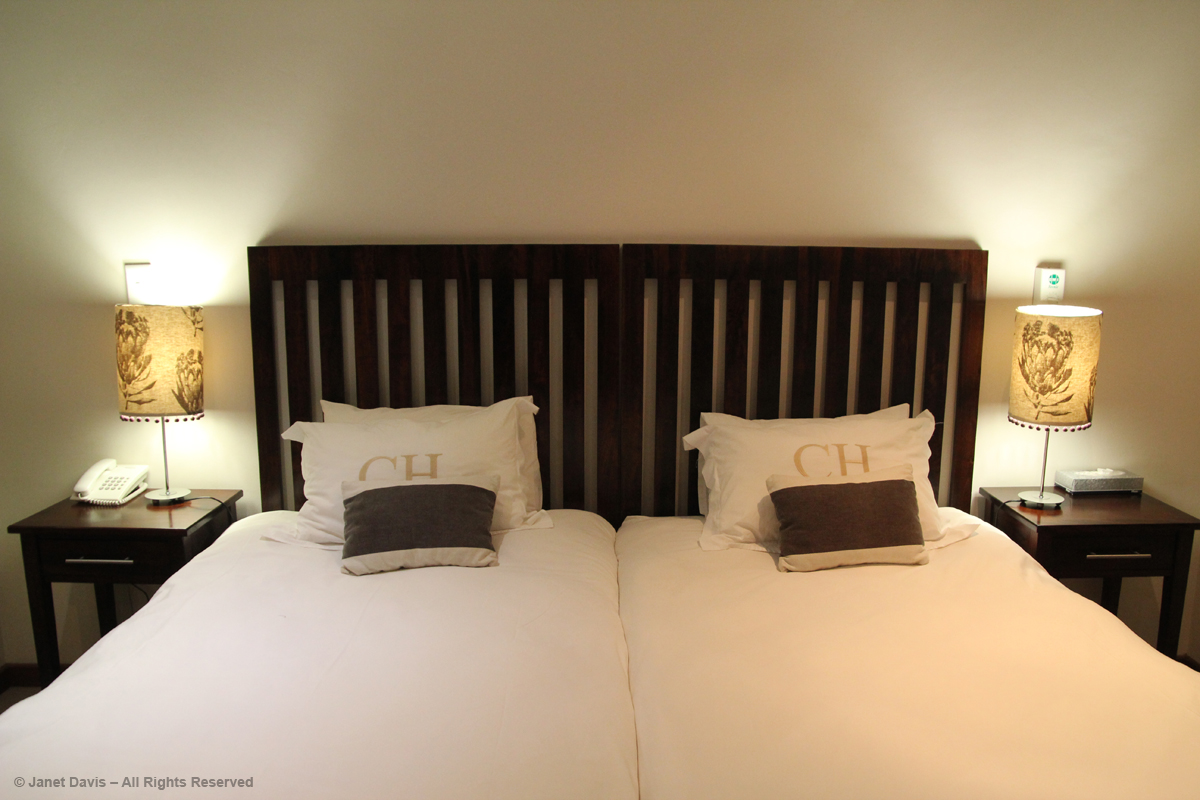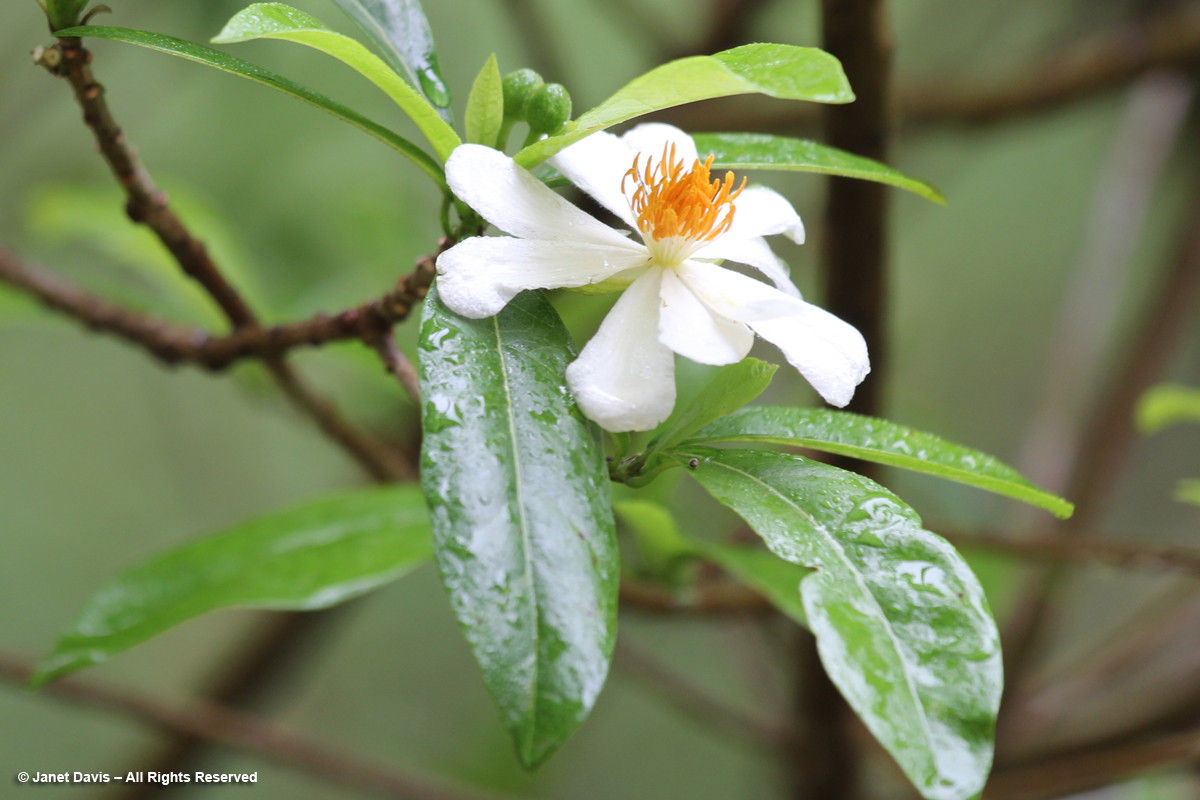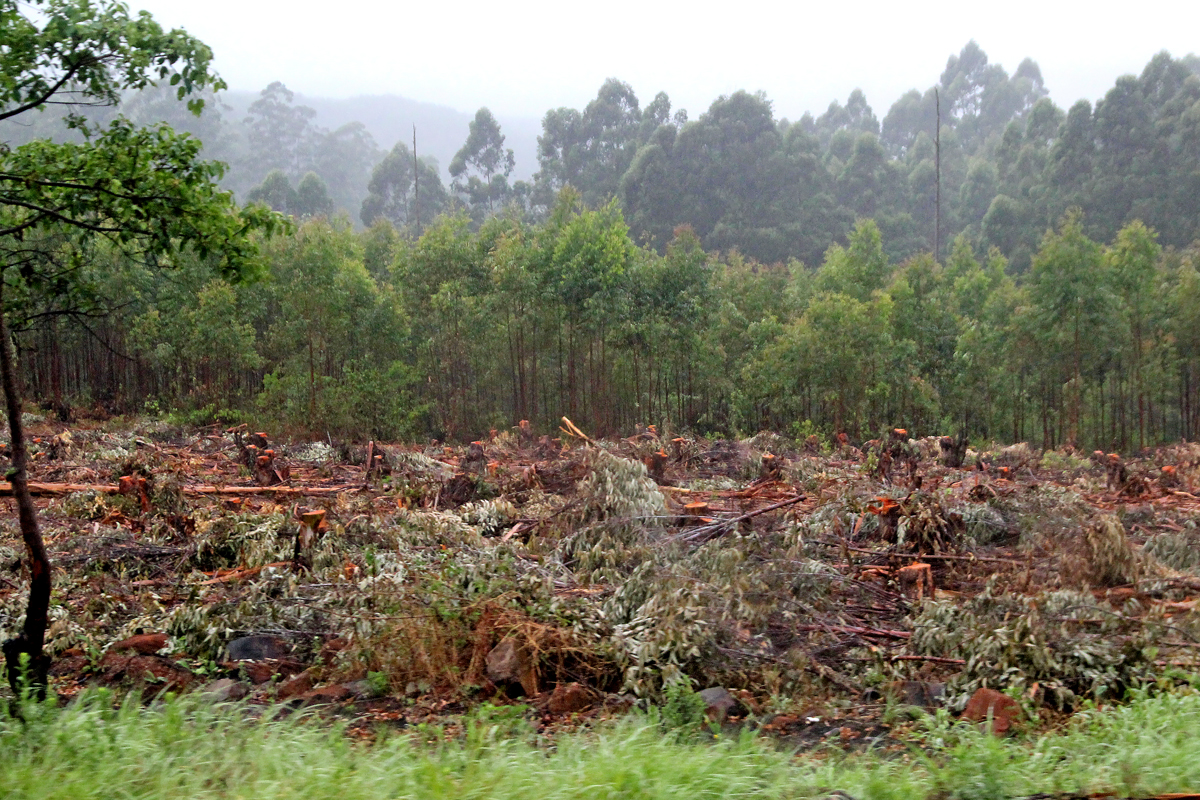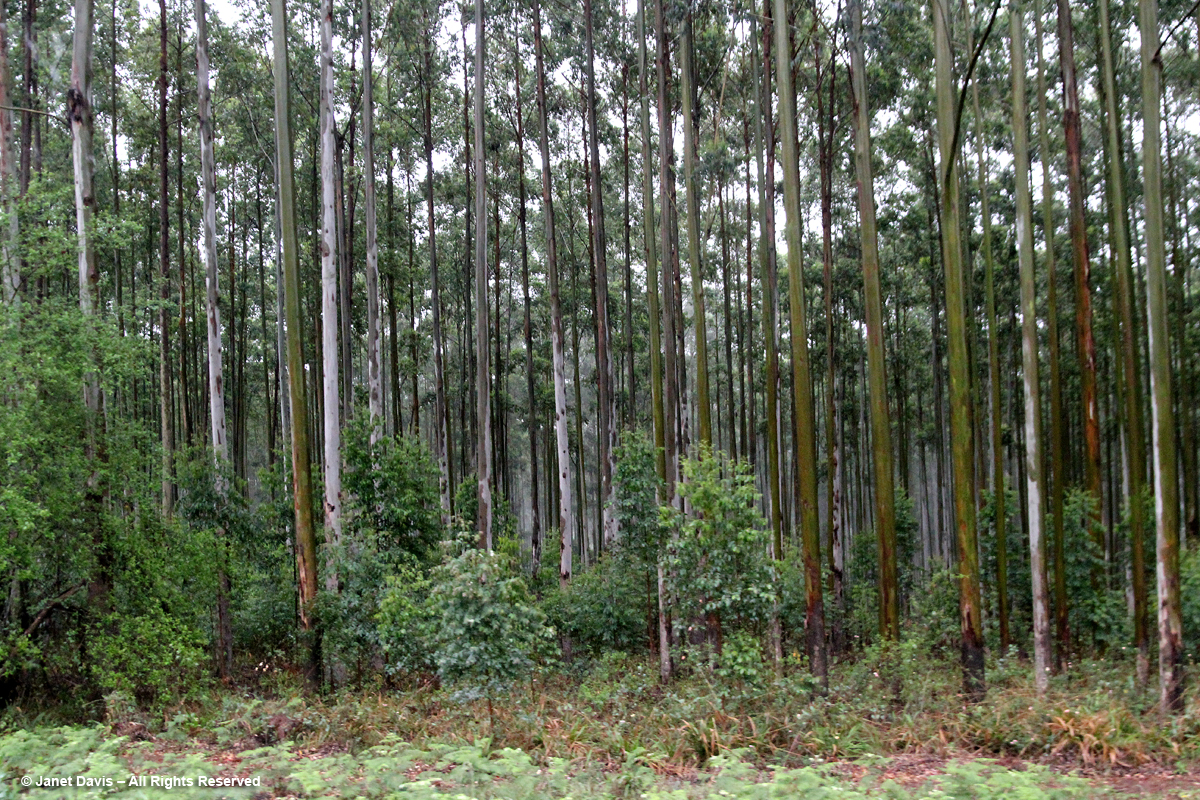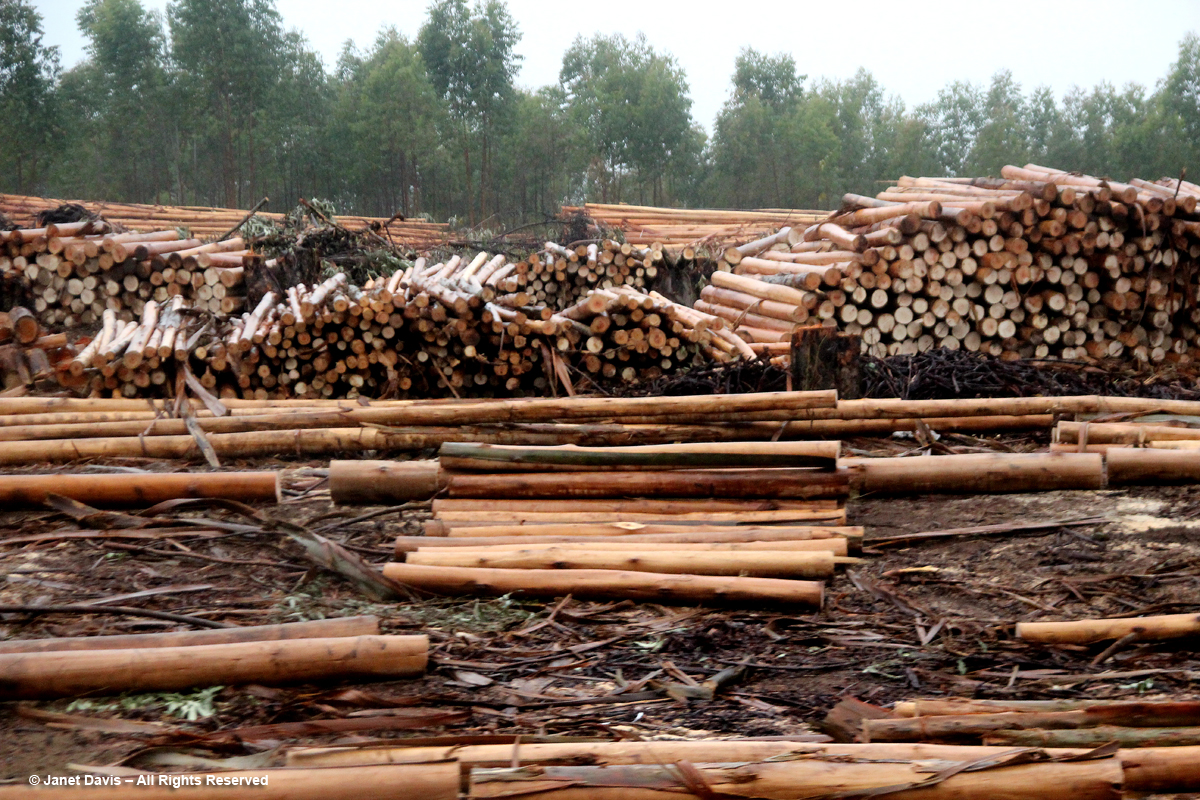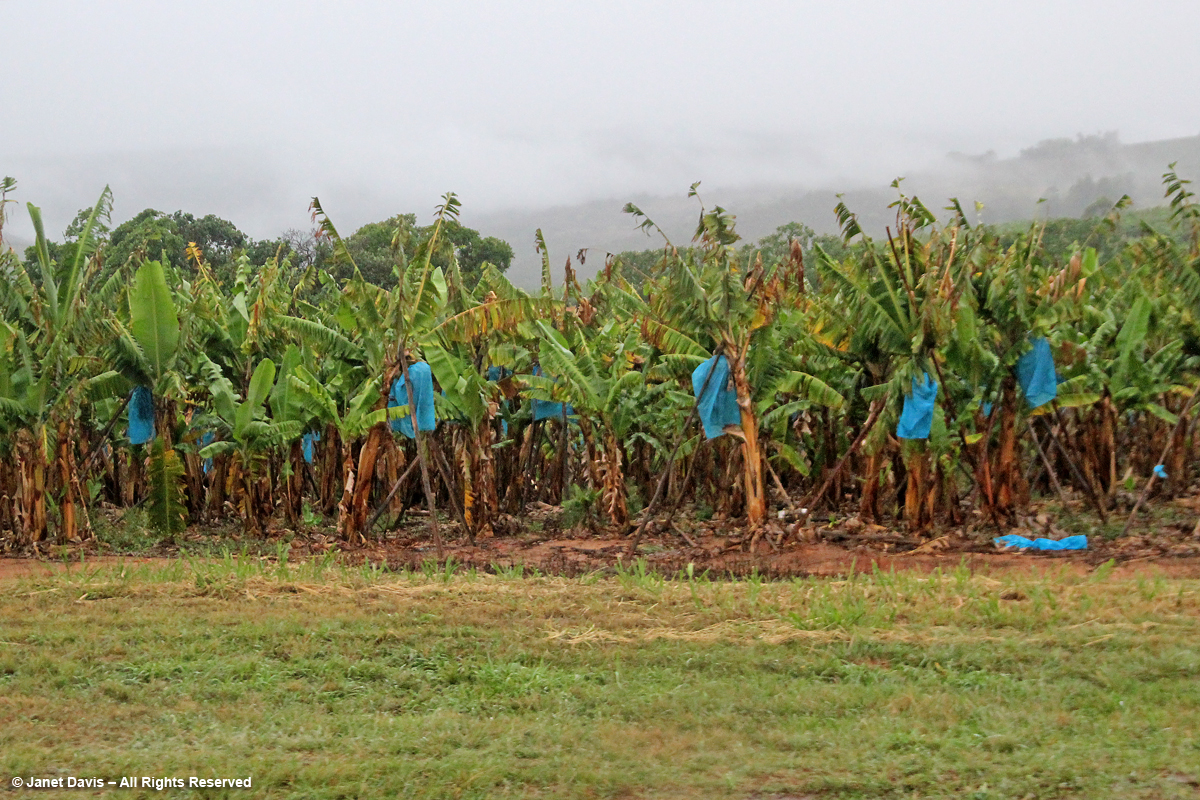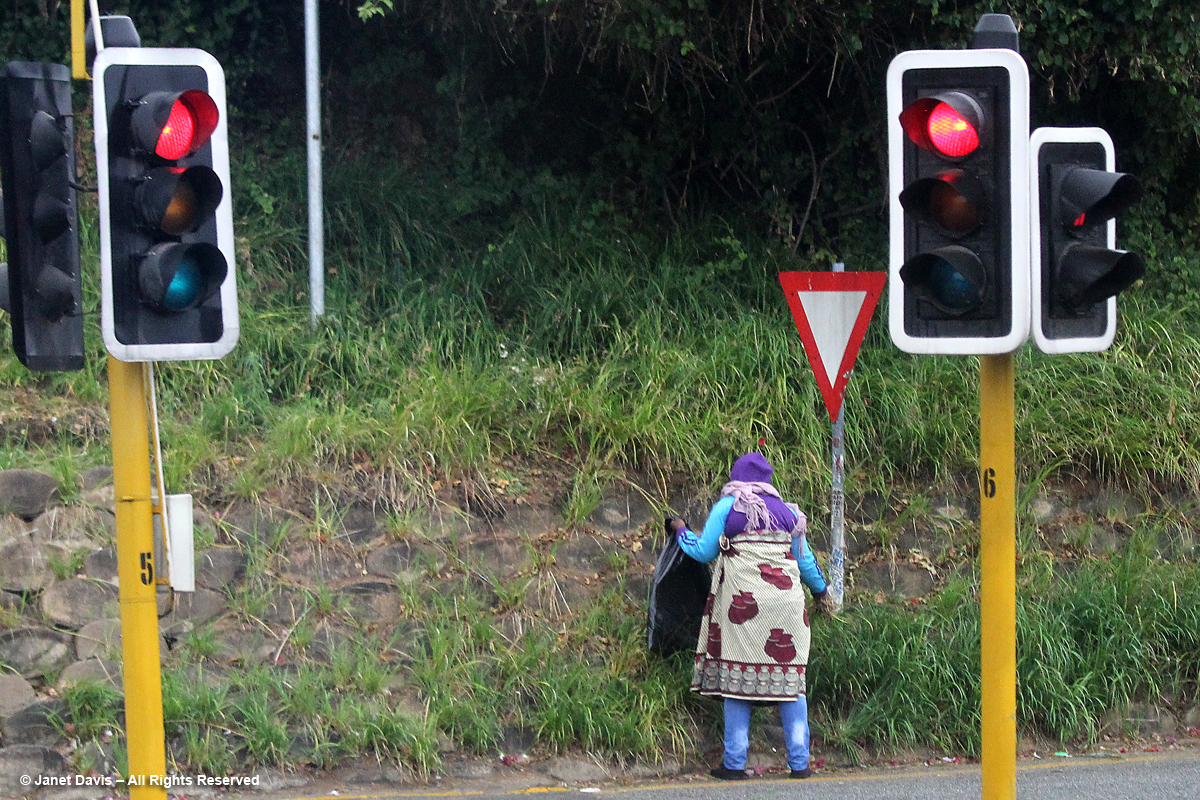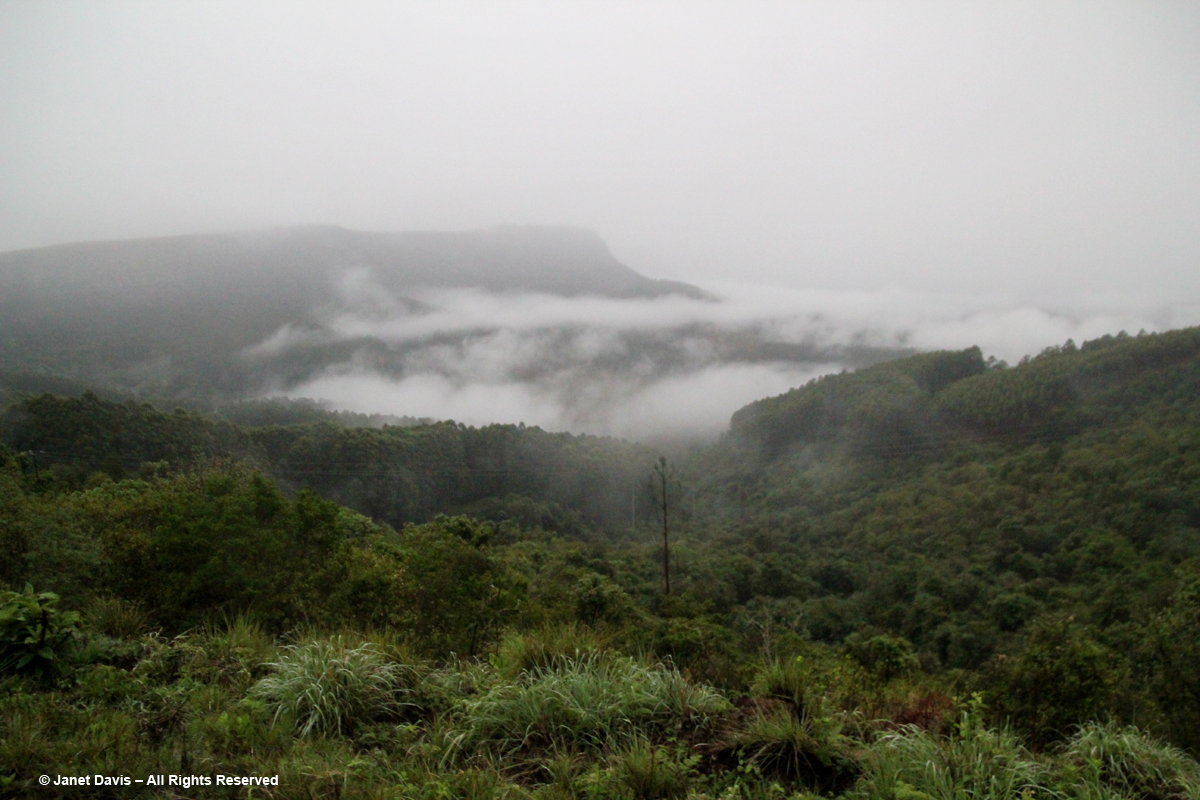It’s the afternoon of our second full day in Johannesburg, South Africa. Having visited a number of private gardens, including beautiful Beechwood Gardens this morning, we’re on the bus headed northeast to the Kapama Game Park near Kruger National Park for our two-day safari (a part of this 2-week garden tour we’re really looking forward to). While it’s true that a bus travelling 50 miles an hour is a photographic challenge, on the other hand you are often passing amazing scenes that you’ll never see again. So, if your camera has an adjustable ISO setting, set it to a fast speed of 1600 or 3200 and start clicking. There might be a lot of blurry shots and the quality is not good enough for publication, but it is fine for recalling the details of a once-in-a-lifetime journey like this.
Our principal route is the lower line on this map, but we’ll be resting for the evening in a sweet little hotel in the town of White River, before heading to Kapama the next day via stops at God’s Window and the Bourke’s Luck Potholes in the spectacular Blyde River Canyon.
Johannesburg is in the Gauteng province, one of nine in South Africa. Geographically, it sits on a plateau called highveld. Today, we’ll travel northeast out of Gauteng into Mpumulanga province and tonight we’ll sleep in the lowveld of White River. Not having equivalent language, these velds are confusing to most of us North Americans. But now, on the highveld not far from Johannesburg, we see beautiful rolling hills and native acacias through the bus window.
And we also see the odd splash of purple, the flowering canopy of the beautiful jacaranda trees (J. mimosifolia). Beloved by many South Africans, they are nonetheless exotics from South America which have displaced much of the indigenous wild flora and are now targeted for removal. In a country with so many other needs, it seems paradoxical that funds would be earmarked for this project, but South Africa is quite sophisticated in its embrace of native flora.
We slow to pay a highway toll at Middelburg. Its name came from the fact that it was the “middle” town in the journey between the gold mining town of Lydenburg and Pretoria, capital city of Transvaal.. Though this is generally farming country, it was here that the British had a concentration camp during the Second Boer War of 1899-1902, at the end of which the South African Republic and the Free Orange State were annexed to the British Empire.
South Africa is mineral-rich and its prosperity, beginning with the 1866 discovery of diamonds in the Kimberley Cape and the Johannesburg Gold Rush of 1886 is still largely built on the profits of mining companies. Still, it’s a bit of a surprise to see piled slag heaps of open-pit mines close to the highway, like this chrome mine. Chrome, of course, is a vital component (with iron) in the manufacture of stainless steel.
And just a few miles away is the pile from an open-pit coal mine. Seventy-seven percent of South Africa’s energy needs are met with coal-fired plants.
We are now in the Crocodile River Valley heading for the Drakensberg escarpment. Northeast of us, the river forms the southern boundary of Kruger National Park.
But this area seems mostly agricultural. Here is a sophisticated irrigation setup on a farm field.
Farming is also of the subsistence variety, as with this small house and yard. There are a number of ethnicities in Mpumalanga province, but this region is mostly home to the Nguni people and we see the Nguni cows wandering along the roadside from time to time.
South Africa’s black population is divided into 4 major ethnic groups: 1) Nguni (Zulu, Xhosa, Ndebele and Swazi), 2) Sotho, 3) Shangaan-Tsonga and 4) Venda. The largest population is Zulu and Xhosa. Of the white population, approximately 60% is of Afrikaans heritage with the remaining 40% British or European. Then there is a mixed race population, mostly of indigenous Khoisan peoples combined with African slaves and white settlers. There are 11 official languages: Zulu (22.75%), Xhosa (16%), Afrikaans (13.5%), English (9.6%), Sepedi (9.1%), Tswana (8%), Southern Sotoho (7.6%), Tsonga (4.5%), Swazi or SiSwati (2.5%), Venda (2.4%) and Ndebele (2.1%).
Our wonderful South African tour guide, Deon Romijn is Afrikaans. He is also a remarkable font of information about his country, its geology (his degree was in geology), its customs, its politics and its people. I worry that my many questions will tire him, but he assures me they do not.
Deon grew up on a farm in Pretoria and speaks all 11 languages, including the Xhosa’s famous click-language. Later in the trip I ask our him to give me a short sample of Xhosa. He complies….
https://plus.google.com/106548255417361407356/posts/QSMe7eAJBtA
Of course there’s no one who makes the click sound quite like Mama Africa, the amazing Miriam Makeba (1932-2008). Hailing from Johannesburg where she was born to a Xhosa father and Zulu mother, she was my first exposure to this magical language. When I was but a young teen and she was but a young woman. I had heard her singing the Click Song in a concert in Vancouver on her inaugural North American tour with Harry Belafonte. Here she is in a 1974 concert in Zaire, Congo, speaking to the audience in French, but clicking in Xhosa…..
Back to the bus. We pass a field of sweet prickly pear cactus (Opuntia ficus-indica), their fruit (itolofiya in Xhosa and turksvy in Afrikaans) an important edible for many, including Xhosa women who use them to make a kind of beer. Spined prickly pears or doornblad were once the target of a massive government eradication program to protect farms; however since there is an established prickly pear company in the area, this field may well be the spineless (kaalblad) prickly pear hybrids developed in California by Luther Burbank.
As we pass through low-lying, foggy valleys we begin to see the first plantations of Australian red gum trees (Eucalyptus camaldulensis). These are part of 4-million square kilometres of man-made forests (termed afforestation), mostly of red and blue gums (E. grandis) and various pines (P. patula, P. elliottii, P. taeda). On the far side of the Drakensberg escarpment, we will see many more gum tree plantations.
We now pass by the little town of Waterval Boven, then into a tunnel under the Drakensberg.
On the other side of the mountains the landscape is amazingly different, with bitter aloes (Aloe ferox) dotting the grassy slopes of the hills amidst acacias. Winter-blooming, they are now out of flower in the southern hemisphere spring.
We pass numerous fruit plantations of avocado, guava and mangoes, below.
A little settlement with vegetables fenced off from wild animals.
We stop for gas and I wander around a bit. This tall, yellow-flowered shrub catches my eye – it’s Tecoma stans or yellow bells, a pretty but invasive native of the Americas. Its a weed here in South Africa, as it is in many parts of the world, including India and China.
Back on the road, we pass the Giraffe Stadium near Nelspruit, more properly called the Mbombela Stadium. One of 10 stadiums build for the 2010 FIFA World Cup, it is charming in its architecture, but also represented the great disparity of fortune in this nation, despite the proud face shown to the world during the soccer championships.
As we near our hotel in White River, we pass a number of fruit vendors. This pair is selling avocadoes and other fruit farmed nearby.
We arrive at our lovely rest for the night: the Casterbridge Hollow Boutique Hotel.
After freshening up, it’s just a short walk to dinner, then to bed. It’s been a long day.
Rain begins in the night so the next morning the garden is wet, but I’m intrigued by an unusual shrub with camellia-like flowers. I later learn it’s the Africa dog rose, Xylotheca kraussiana.
After breakfast, we’re back on the bus and soon travelling again between the big gum forests of Mpumalanga. This one has been freshly logged….
…While the one below has been interplanted with young stock. Gum trees are harvested at 15 years so interplanting of saplings is done at approximately 7 years. Prior to 1972 when gold mining formed the main industry in the region, this area was indigenous forest, but once gold mining stopped, permits were granted to grow these forests. Some of those permits are now expiring and the area will return to indigenous forest.
Gum tree timber is used extensively as mine pit props, telephone poles and in pulp and paper production.
We pass a banana plantation with the bunches wrapped in blue plastic bags. Our guide said this was so they don’t ripen too fast, and also to protect them against marauding birds, monkeys and other animals. (Having Googled this, I see that these blue bags are ubiquitous on banana plantations around the world; in some places they also refer to the bags protecting the fruit from rain that causes blemishes.) All first class fruit is for the export market, sent to Asia and Europe. South Africans get second and third class fruit.
The woman below is picking some type of grass or herbs from the side of the highway. Deon says she is likely harvesting plants for muti or traditional medicine. Her garment seems to have some significance, but I was unable to learn what that might be by looking online. A mystery (and some things should remain that way!) – NB: Thanks to Namhla in comments below, I can confirm that the woman is wearing the traditional wrap of a sangoma, a healer.
Finally we arrive in the Blyde River Canyon area, but the heavy mist will likely make our next stop problematic. That’s my next blog! Stay tuned….

